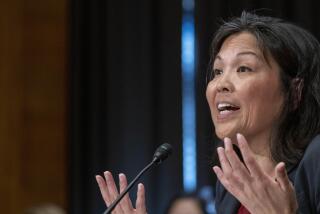Trump administration moves to end food stamps for 3 million people

- Share via
The Trump administration is moving to end food stamp benefits for 3 million people with proposed new regulations curtailing the leeway of states to automatically enroll residents who receive welfare benefits.
Agriculture Secretary Sonny Perdue said state governments “have misused this flexibility.”
“We are changing the rules, preventing abuse of a critical safety net system, so those who need food assistance the most are the only ones who receive it,” he added.
Conservatives have long sought cuts in the federal food assistance program for the poor and disabled. House Republicans tried to impose similar restrictions on the food stamp program last year when Congress renewed it but were rebuffed in the Senate.
The proposed change in rules for the Supplemental Nutrition Assistance Program — often called by its former name, food stamps — would deliver on the goal as the administration has agreed to a deal to lift caps on federal spending.
Debbie Stabenow of Michigan, the top-ranking Democrat on the Senate Agriculture Committee, said the Agriculture Department’s action “is yet another attempt by this administration to circumvent Congress and make harmful changes to nutrition assistance that have been repeatedly rejected on a bipartisan basis.”
“This rule would take food away from families, prevent children from getting school meals and make it harder for states to administer food assistance,” the Michigan senator added.
Income Cap
The Trump administration rule would rein in states’ ability to enroll recipients earning more than 130% of the federal poverty guidelines — in most cases capping eligibility to an annual income of $32,640 for a family of four.
Forty states and the District of Columbia currently use alternative eligibility criteria that allow participants in some federally funded welfare programs to automatically receive food stamps as long as their income is less than double the poverty level.
Brandon Lipps, an acting deputy undersecretary in the Agriculture Department, told reporters in a conference call previewing the regulatory changes that in some cases states enroll residents for food stamps even though they are receiving federal welfare benefits of minimal value — including brochures.
The proposed regulations, to be released Tuesday, would only allow automatic enrollment of people who receive welfare benefits worth at least $50 a month on an ongoing basis for at least six months. Other than cash, the only welfare benefits that would qualify are subsidized employment, work supports such as transportation, and child care, Lipps said.
The proposed restrictions would eliminate food stamps for 3 million people at an average annual savings of $2.5 billion, Lipps said. A final regulation will be issued after a 60-day public comment period.
As of April, 36 million Americans received food stamps, with an average monthly benefit of $121 per person, according to the Department of Agriculture. Enrollment has declined as the economy has improved and was down 2.5 million from a year earlier.
The federal government pays the cost of food stamp benefits. But states administer the program and determine eligibility of applicants, with the state and federal government splitting administrative costs.
Cutting back automatic enrollment would have a substantial effect, mostly hitting recipients who receive lower monthly benefits and disproportionately affecting working families with children trying to climb out of poverty, Elaine Waxman, a senior fellow at the Urban Institute, said in testimony last month to a House Agriculture subcommittee.
“We particularly worry about food‐insecure households with kids and adolescents,” Waxman said. “Food-insecure children have higher rates of fair and poor health, have higher rates of hospitalization, increased risk of asthma, and delays in cognitive developments.”
More to Read
Get the L.A. Times Politics newsletter
Deeply reported insights into legislation, politics and policy from Sacramento, Washington and beyond. In your inbox three times per week.
You may occasionally receive promotional content from the Los Angeles Times.










